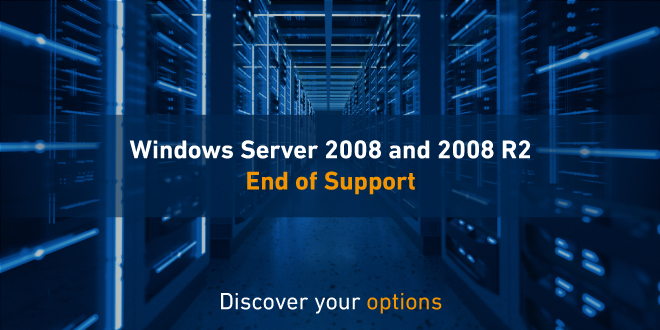
Windows Server 2008 and 2008 R2 End of Support: Discover your options
On January 14, 2020, support for Windows Server 2008 and 2008 R2 came to an end. End of support or end of life refers to the date when Microsoft no longer provides automatic fixes, security updates, or online technical assistance. As a result, any vulnerabilities in the operating system that are discovered after this date will not be fixed by Microsoft. What’s more, Microsoft will no longer offer any type of support for the operating system meaning it won’t be long before those systems are specifically targeted and exploited.
Now is a great time to transform your applications and infrastructure to take advantage of cloud computing and the latest versions of Windows Server. Here’s a few options and tools to help you and your business manage the transition:
Migrate to Azure
Now you might be thinking that end of support is an ideal time to transform your IT estate with the cloud – and you’d be right. But it can be difficult to have upgraded everything before an end of support timeline.
To address this need, Microsoft has made Extended Security Updates available for free in Azure for 2008 and 2008 R2 versions of Windows Server to help secure workloads for three more years after the end of support deadline.
These workloads can be rehosted to Azure with no application code change allowing businesses more crucial time to plan their future paths, including upgrading to newer versions such as Windows Server 2016 and utilising the set of platform and data services available in Azure.
Upgrade on-premise environments
For any apps and data that you want to keep running from your premises, your best option is to upgrade to the latest version of Windows Server to get the strongest security and latest innovation. Windows Server 2016 are the new standard for performance and efficiency, and include built-in security features that help harden your platform.
If you are staying on-premise, this is the ideal time to look at your entire server infrastructure. Whilst today’s server solutions can deliver important security features, as well as dramatically increase both performance and cost-efficiency, they can still be a burden to manage and take up valuable space within your office footprint.
Talking to a Managed Hosting partner who can manage your journey from your traditional on-premises environment to an environment hosted in a purpose-built data centre can be advantageous. You can focus on your business whilst they focus on your IT estate.
It you really do need more time to upgrade your on-premise servers, Extended Security Updates are available for purchase for up to three more years and are a great option for achieving continual security updates while upgrading or migrating to Azure. This option is available to organisations with Software Assurance or Subscription licenses under an Enterprise Agreement enrolment and can be purchased annually to cover only the servers that require the updates.This option can be expensive though and is only really postponing the inevitable.
Next steps…
Now that we’ve covered more of your options, it’s time to get started. We know that every good migration project begins with a good plan, so start by identifying any applications that are being supported by 2008 and 2008 R2 versions Windows Server, inventory the workloads, and choose the right migration and upgrade path for each one.
You have options and your data doesn’t need to be vulnerable. Whether you are looking to quickly mitigate your risk or using Windows Server end of life as a catalyst for business innovation, Daisy can help.
As a leading partner of Microsoft, we’re ideally placed to combine the globally available Microsoft Azure cloud service with the advanced capability of our own data centres, bringing you a bespoke way to deliver software-as-a-service, infrastructure-as-a-service, unified communications, better collaboration and much more.
There is a lot to think about when planning an infrastructure refresh, embarking on a cloud journey or planning a complete digital transformation.
The most important question is purely strategic and shouldn’t be defined or constrained by what technology you have but solely on, “What are your business objectives?”
This will lead to many other questions relating to your critical functions, processes and workloads, how everything needs to relate to everything else, who needs access to what, at what level and so on.
Once you know what you need, you can evaluate how technology can deliver it – design a solution and develop a roadmap of how to deploy it with minimal disruption to your business.
Daisy has more than 30 years’ experience in doing just this, working with the leading global technology partners – so we are ideally placed to help you. We understand your current environment inside and out, as well as what technology is best suited to meet your individual requirements – because your business is not exactly like any other. Contact us now for help and advice.